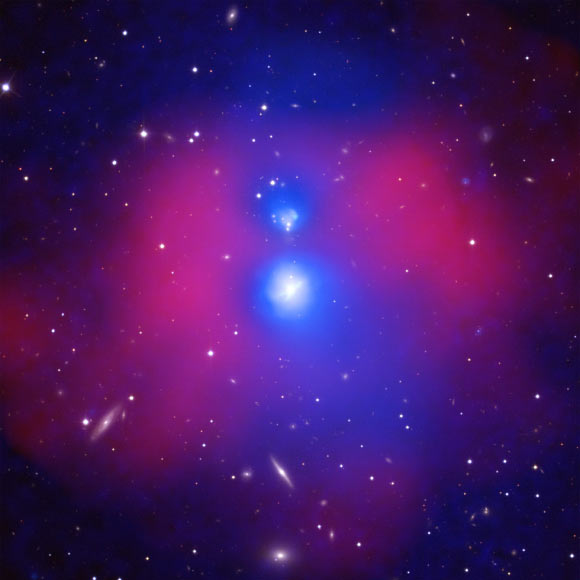NGC 6338: Two Galaxy Groups are Colliding at Incredible Speed | Astronomy – Sci-News.com
Using data from NASA’s Chandra X-ray Observatory, ESA’s XMM-Newton, the Giant Metrewave Radio Telescope, and the Apache Point Observatory, astronomers have found that two groups of galaxies in the merging system NGC 6338 are slamming into each other at a whopping speed of about 6.4 millon km/h (4 million mph). The observations also revealed that the cool cores of these galaxy groups are embedded in a large region of shock-heated gas.

This composite image of the galaxy group-galaxy group merger NGC 6338 contains X-ray data from Chandra (displayed in red) that shows hot gas with temperatures upward of about 20 million degrees Celsius, as well as cooler gas detected with Chandra and XMM (shown in blue) that also emits X-rays. The image contains optical data from the Sloan Digital Sky Survey. Image credit: Chandra / NASA / CXC / SAO / E. O’Sullivan / ESA / XMM / SDSS.
The NGC 6338 galaxy system resides about 380 million light-years from Earth in the constellation of Draco.
The total mass of the system is about 100 trillion solar masses, roughly 83% of which is in the form of dark matter, 16% is in the form of hot gas, and 1% in stars.
Previous studies have provided evidence for the regions of cooler, X-ray emitting gas around the cores of the two galaxy groups in NGC 6338.
“The new Chandra and XMM-Newton data show that the gas to the left and right of the cool cores, and in between them, appears to have been heated by shock fronts formed by the collision,” said Dr. Ewan O’Sullivan from the Harvard-Smithsonian Center for Astrophysics and colleagues.
The presence of shock-heated gas in the group-group mergers has been predicted by computer simulations, but the NGC 6338 system may be the first merger to clearly show it. Such heating will prevent some of the hot gas from cooling down to form new stars.
“A second source of heat commonly found in groups and clusters of galaxies is energy provided by outbursts and jets of high-speed particles generated by supermassive black holes,” the astronomers explained.
“Currently, this source of heat appears to be inactive in NGC 6338 because there is no evidence for jets from supermassive black holes using radio data from the Giant Metrewave Radio Telescope.”
“This absence may explain the filaments of cooling gas detected in X-ray and optical data around the large galaxy in the center of the cool core in the south.”
The findings were published in the Monthly Notices of the Royal Astronomical Society.
_____
Ewan O’Sullivan et al. 2019. Building a cluster: shocks, cavities, and cooling filaments in the group–group merger NGC 6338. MNRAS 488 (2): 2925-2946; doi: 10.1093/mnras/stz1711






